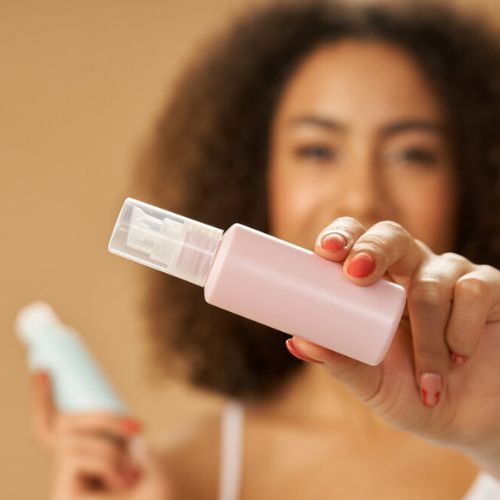If you’re familiar with the different ingredients in hair products, then you are likely to know about emollients for hair. However, if you’re new to the world of hair products, you may not know what an emollient is and how it works.
Emollients are “care” ingredients added to a formulation to impart softness, smoothness, and a lubricious feel.1,2 The word emollience and emollient are Latin-derived words meaning “mollire” or “molly,” which stands for “soft.” Emollients work by coating the hair fibers, helping to retain moisture and improve texture.
To offer a deeper understanding of emollients, their chemical nature, the varieties commonly used in hair care products, and the specific advantages they provide to hair, this guide delves into the subject. For this purpose, I’ve collaborated with a hair scientist and cosmetic formulator holding a PhD in Chemistry. His expert insights will shed light on the critical role emollients play in maintaining and enhancing hair health and appearance.
Emollients: Their Chemical Nature

Emollients are organic molecules with a long carbon chain having different functional groups attached to them, such as esters, alcohols, and fatty acids. This diverse range of functional groups demonstrates the varied chemistry of emollients.
Certain emollient ingredients have polar properties, while others are strongly non-polar and do not dissolve in water. The chemical bonding of the emollient molecule determines how it affects the hair fiber and ultimately, the results.
Formulator chemists are very careful when choosing an emollient or blend of emollients. They consider the desired results, claim substantiation, and compatibility with other ingredients in the formulation.3
They are used widely in hair conditioners, deep conditioning masks, hair styling creams, pomades, gels, and shampoos. Some simple and commonly used emollients in hair care products are:
- C12-C15 Alkyl Benzoate
- Cetyl Palmitate
- Cetyl Esters
- Isopropyl Myristate
The Role of Emollients for Hair
The surface of the hair is where the main action takes place. Most people desire to have hair that feels soft, smooth, and has a pleasant texture when touched.
Excessive and aggressive combing and brushing can cause physical damage to your hair, as well as harsh chemical treatments. This can result in a damaged cuticle layer and rough hair with increased friction-to-fiber friction. As a result, your hair may not feel soft or provide a pleasant sensory experience.
Studies have revealed that emollient molecules, which have a long history in skincare science for improving skin smoothness and preventing water loss, can also benefit hair fiber when applied in rinse-off or leave-in formulations.4,5 Therefore, the main objective of having emollient ingredients in hair care formulation is to enhance the physical properties of hair surfaces and improve their sensorial feel.
Some key benefits are listed here:
● Improved surface smoothness.
● Softness.
● Boost sensorial feel.
● Impart shine and make hair glossy.
● Prevent water loss from the scalp & fiber.
● Lubricate the shaft and reduce fiber-to-fiber friction.
Emollients vs. Moisturizers

The terms “emollient” and “moisturizer” are often used in cosmetic literature and product labels, but they have distinct meanings despite being used interchangeably.
Emollients are ingredients added to prevent water loss from the surface (skin or hair), while moisturizers enhance or maintain the water level of the surface (skin or hair).
So, to put it simply, emollients are generally hydrophobic that prevent the evaporation of water molecules while moisturizers have two ways to do the job. It can either add water molecules to the fiber or maintain the water level constant by preventing water loss.
Moisturizer is a broad term covering humectants as well as oil-based occlusive agents. Therefore, an emollient can be a moisturizer by preventing water loss.
Types of Emollients for Hair
Hair care products use many different types of emollient ingredients, but they are classified based on their chemical nature. Below, we’ll categorize emollients into two main categories – synthetic and natural.
Synthetic Man-Made Emollients
Esters
Esters are chemical compounds having ester linkage in their chemical structure. When used for cosmetics, a fatty acid is reacted with organic alcohol to prepare a long-chain fatty ester.
A typical common example is isopropyl myristate (IPM) where myristic acid is coupled with isopropyl alcohol. The length of the carbon chain of fatty acid and the nature of the alcohol define the physical properties of the resultant emollient molecule.
Esters are mostly inert and have good compatibility with skin. Depending upon the carbon chain, emollient can be water-soluble or insoluble.
Hydrophilic emollients (water soluble) are preferred for cleansing products (shampoos, body wash, etc.) while hydrophobic (water-insoluble or dispersible) are added into hair conditioners, deep conditioning masks, and creams.
Some examples are:
- Cetyl Ester
- Cetyl Lactate (A lactic acid ester)
- C12-C15 Alkyl Lactate
- Myristyl Myristate
Today, formulators have access to a wide variety of ester molecules, each with its own benefits for formulations. A product can include a combination of emollients to achieve the desired results.
Petroleum Derived
Petrolatum, petroleum jelly, and mineral oil are types of emollients and occlusive agents that come from petroleum. They contain long-chain hydrocarbons and are highly hydrophobic, meaning that they resist water.
When applied to the hair, they help keep the hair shaft lubricated and create a water-resistant barrier on the surface of the scalp. This makes them a great option for people who have dry, itchy, or compromised scalps and need to prevent water loss.
A disadvantage of using petroleum-derived ingredients in cosmetics is that they are not sustainable and do not align with the growing consumer preference for natural, green, and readily biodegradable ingredients. While these ingredients may be beneficial and gentle on the skin, natural emollients are preferred instead.
Silicones
Silicone oils are excellent emollients with strong water-resistant benefits. They are long-chain silicone polymers with varying viscosity, molecular weight, and structure. Because they react well with sunlight, they make hair look shinier when applied.
They also make hair smoother and improve its feel by forming a film around the hair shaft, and they safeguard against solar radiation and thermal treatments.6
Some examples are:
- Cyclopentasiloxane
- Dimethicone
- Cyclomethicone
- Phenyltrimethicone
Nevertheless, it is important to note that silicone oils are also prone to build-up. Due to their high molecular weight and low solubility in water, they are challenging to remove and do not easily come off the surface of the hair.
Repeatedly applying the silicones can lead to a build-up of deposits on the hair, causing it to become heavy and greasy with a limp appearance.
Natural Emollients
The first cosmetic products used topically for dry and damaged skin are most likely natural emollient ingredients, primarily oils, butter, or waxes from plants. Mother Nature has provided us with a range of such ingredients that have amazing benefits without any discomfort to the skin or scalp.
Today, a wide range of natural emollients is available that offer diverse options for both formulators and consumers. These emollients are multifunctional, safe, highly skin-friendly, and sourced sustainably.
Oils, Butter
Since ancient times, oils and butter extracted from plants have been used in personal grooming. These oils and butter have different chemical compositions, carbon chain lengths, and chemical bonding.
Oils typically are mono, di, or poly-unsaturated fatty acids, while butter is saturated fatty acids. This explains why oils are liquid at room temperature, while butter is solid or semi-solid.
These differences in physical state and chemical properties can greatly affect their effects on the scalp and hair.
The oils and butter are known for their ability to moisturize and protect hair shafts from sunlight and oxidative harm. They also make it easier to comb and brush by lubricating the shaft.
Moreover, these emollients offer benefits such as nerve soothing, antimicrobial properties, and dermatological care for damaged and dry scalp surfaces.
Some favorite natural emollients are:
- Sunflower Oil
- Coconut Oil
- Argan Oil
- Apricot Kernel Oil
- Babassu Oil
- Shea Butter
- Mango Butter
- Cocoa Butter
Waxes
Wax can be obtained from natural sources while synthetic waxes are also available. Natural wax materials are surely in high demand due to their sustainability and green origin. For example, Beeswax is an excellent emollient used in topical skin care moisturizing products.
Other examples of waxes used in hair care products are carnauba wax and candela wax. They are commonly found in hair styling creams and waxes as they provide good emollience and moisturizing benefits and help with style retention.7
These natural waxes blend long-chain fatty acids, lipids, sterols, and organic antioxidants. Due to their multifunctional properties, these wax materials offer multiple benefits to the formulation.
Some examples of natural waxes are:
- Beeswax
- Carnauba Wax
- Sunflower Wax
- Rice Bran Wax
Do Emollients Lead to Build-Up?
The short answer is yes, but the extent of this build-up largely depends on the chemical nature of the emollient and how it adheres to the hair shaft.
Emollients that are synthetic and possess high hydrophobic qualities—such as petrolatum, petroleum jelly, and silicone oils—tend to be more difficult to wash out. Their film forms a barrier that doesn’t easily dissolve in water, leading to accumulation on the hair.
To minimize such build-up, it’s wise to steer clear of these types of emollients when possible. Moreover, incorporating a clarifying shampoo into your hair care routine at least once a week can help eliminate any residue left by these products, ensuring your hair remains clean and healthy.
Summary
Almost every hair care product contains emollients, which help to make hair soft, smooth its surface, and provide lubrication to the cuticle layer, making it easier to comb.
Natural oils and butter are better than petroleum-derived ingredients for hair and scalp because of their sustainable supply chain, green origin, and multifunctional benefits. They also provide superior emollience and performance.
References
- Schueller, R.; Romanowski, P., Conditioning Agents for Hair and Skin. Taylor & Francis: 1999. ↩︎
- Elsner, P.; Maibach, H. I., Cosmeceuticals and Active Cosmetics: Drugs vs. Cosmetics. Taylor & Francis: 2005. ↩︎
- Goldenberg, R., Correlation of skin feel of emollients to their chemical structure. J. Soc. Cosmet. Chem 1971, 22, 635-654. ↩︎
- Dederen, J. C.; Chavan, B.; Rawlings, A. V., Emollients are more than sensory ingredients: the case of Isostearyl Isostearate. Inter. J. of Cosmet. Sci 2012, 34 (6), 502-510. ↩︎
- Haake, H. M.; Lagrene, H.; Brands, A.; Eisfeld, W.; Melchior, D., Determination of the substantivity of emollients to human hair. J. Cosmet. Sci. 2007, 58 (4), 443-450. ↩︎
- O’Lenick, A. J., Silicones for personal care. Allured Pub. Carol Stream, IL: 2008. ↩︎
- Morante, N., Waxes Used in the Cosmetics Industry. 2007. ↩︎















